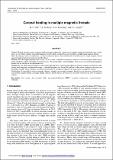Files in this item
Coronal heating in multiple magnetic threads
Item metadata
| dc.contributor.author | Tam, Kuan Vai | |
| dc.contributor.author | Hood, Alan William | |
| dc.contributor.author | Browning, Philippa | |
| dc.contributor.author | Cargill, Peter | |
| dc.date.accessioned | 2015-08-18T08:10:02Z | |
| dc.date.available | 2015-08-18T08:10:02Z | |
| dc.date.issued | 2015-08 | |
| dc.identifier | 199483000 | |
| dc.identifier | eac523c0-0b90-4962-8238-201ec861c171 | |
| dc.identifier | 84939805473 | |
| dc.identifier | 000360020200122 | |
| dc.identifier.citation | Tam , K V , Hood , A W , Browning , P & Cargill , P 2015 , ' Coronal heating in multiple magnetic threads ' , Astronomy & Astrophysics , vol. 580 , A122 . https://doi.org/10.1051/0004-6361/201525995 | en |
| dc.identifier.issn | 0004-6361 | |
| dc.identifier.other | ORCID: /0000-0003-2620-2068/work/58055183 | |
| dc.identifier.uri | https://hdl.handle.net/10023/7259 | |
| dc.description | We acknowledge the financial support of STFC through the Consolidated grant to the University of St Andrews. | en |
| dc.description.abstract | Context. Heating the solar corona to several million degrees requires the conversion of magnetic energy into thermal energy. In this paper, we investigate whether an unstable magnetic thread within a coronal loop can destabilise a neighbouring magnetic thread. Aims. By running a series of simulations, we aim to understand under what conditions the destabilisation of a single magnetic thread can also trigger a release of energy in a nearby thread. Methods. The 3D magnetohydrodynamics code, Lare3d, is used to simulate the temporal evolution of coronal magnetic fields during a kink instability and the subsequent relaxation process. We assume that a coronal magnetic loop consists of non-potential magnetic threads that are initially in an equilibrium state. Results. The non-linear kink instability in one magnetic thread forms a helical current sheet and initiates magnetic reconnection. The current sheet fragments, and magnetic energy is released throughout that thread. We find that, under certain conditions, this event can destabilise a nearby thread, which is a necessary requirement for starting an avalanche of energy release in magnetic threads. Conclusions. It is possible to initiate an energy release in a nearby, non-potential magnetic thread, because the energy released from one unstable magnetic thread can trigger energy release in nearby threads, provided that the nearby structures are close to marginal stability. | |
| dc.format.extent | 16 | |
| dc.format.extent | 1865660 | |
| dc.language.iso | eng | |
| dc.relation.ispartof | Astronomy & Astrophysics | en |
| dc.subject | Sun: corona | en |
| dc.subject | Sun: magnetic fields | en |
| dc.subject | Magnetohydrodynamics (MHD) | en |
| dc.subject | Magnetic reconnection | en |
| dc.subject | Coronal heating | en |
| dc.subject | Avalanche | en |
| dc.subject | QB Astronomy | en |
| dc.subject | QC Physics | en |
| dc.subject | NDAS | en |
| dc.subject.lcc | QB | en |
| dc.subject.lcc | QC | en |
| dc.title | Coronal heating in multiple magnetic threads | en |
| dc.type | Journal article | en |
| dc.contributor.sponsor | Science & Technology Facilities Council | en |
| dc.contributor.sponsor | Science & Technology Facilities Council | en |
| dc.contributor.institution | University of St Andrews. Applied Mathematics | en |
| dc.contributor.institution | University of St Andrews. School of Mathematics and Statistics | en |
| dc.identifier.doi | 10.1051/0004-6361/201525995 | |
| dc.description.status | Peer reviewed | en |
| dc.identifier.grantnumber | ST/K000950/1 | en |
| dc.identifier.grantnumber | ST/L005522/1 | en |
This item appears in the following Collection(s)
Items in the St Andrews Research Repository are protected by copyright, with all rights reserved, unless otherwise indicated.

